Among the poppies there are different types with very different life forms and flower colors. We introduce you to the most beautiful poppy species and varieties for the garden.

The poppy species of the genus Papaver belong to the poppy family (Papaveraceae) and are bleeding heart (Lamprocapnos spectabilis), Corydalis (Corydalis) and celandine (Chelidonium majus) distantly related. They form a deep taproot, which enables them to pull up moisture from deep layers of soil. The pinnate leaves can be glabrous or very hairy. The poisonous milky sap that escapes when a stalk or leaf breaks off is typical of the poppy family. It can be white, orange or red in colour.
contents
- Poppy Varieties and Species: How Many Are There?
-
The most beautiful poppy species and varieties at a glance
- Alpine poppy (Papaver alpinum)
- Medicinal poppy (Papaver bracteatum)
- Iceland poppy (Papaver nudicaule)
- Corn poppy (Papaver rhoeas)
- Ladybird poppy (Papaver commutatum)
- Opium poppy (Papaver somniferum)
- Spanish poppy (Papaver rupifragum)
- Turkish poppy (Papaver orientale)
- Dwarf poppy (Papaver miyabeanum)
Poppies form a cupped flower with usually 4 petals and a central ovary surrounded by numerous stamens. Below the petals are two sepals that close the flower bud before the flower opens. After pollination, innumerable tiny seeds are formed in capsules which, when ripe, open and disperse the seeds.
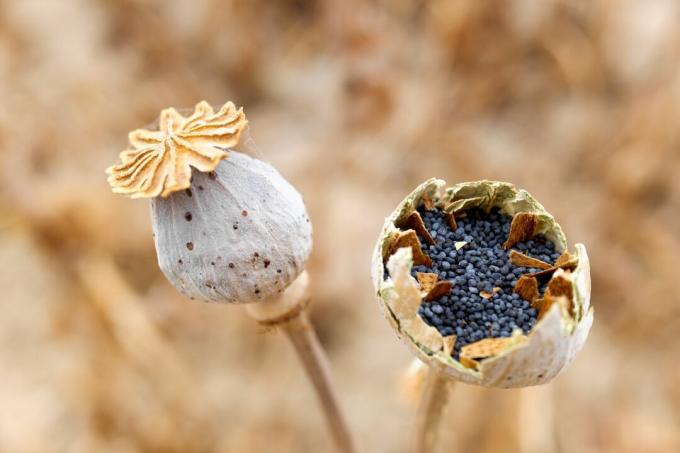
Poppy Varieties and Species: How Many Are There?
Poppy species are mainly found in the moderate latitudes up to the border of the subtropics in the northern hemisphere. Over 50 styles will be added Papaver counted, but only a handful of these are widespread in our gardens and fields as ornamental and useful plants. Poppies generally do best in well-drained, rather poor, dry to moderately moist soil in full sun.
The most beautiful poppy species and varieties at a glance
Among the different types and varieties of poppies, there is a wide variety of flower colors, growth heights and lifespans to choose from. The poppies present themselves as annuals, biennials or perennials, growing between 10 and 150 cm and in a wide variety of colours. They are well suited as cut flowers, the seed pods as a decoration for dried bouquets or for seed production. We provide domestic poppies and the most common types and Papaver- Varieties for planting in the garden.
Tip: The California poppy (Eschscholzia californica), also called golden poppy, and the Tibetan pseudopoppy (Meconopsis) do not belong to the genus Papaver, but are nevertheless poppy plants and therefore related species.

Alpine poppy (Papaver alpinum)
Alpine poppies thrive on calcareous debris areas in full sun and are therefore extremely robust against weather and drought. It occurs throughout the Alps up to over 2000 m. The alpine poppy is a perennial species that grows between 5 and 20 cm high. It forms a basal, strong rosette of leaves and leafless flower stalks. The flowering period begins between July and August. It shows white to yellow, fourfold and about 5 cm large flowers. Alpine poppy can be planted well in the rock garden or alpinum, where it propagates by self-seeding.
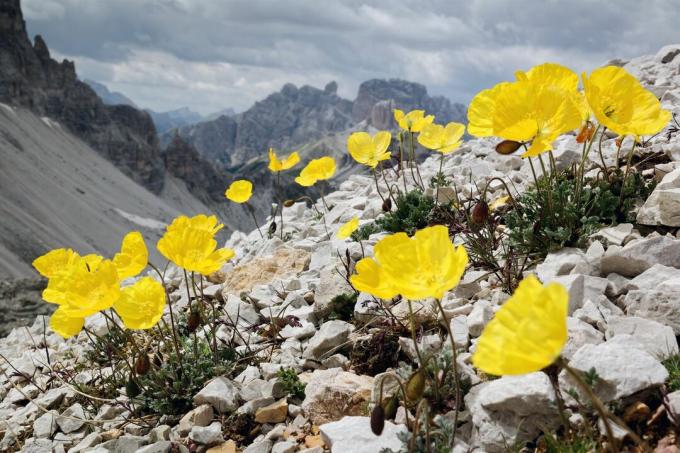
Medicinal poppy (Papaver bracteatum)
The medicinal poppy, also known as the Armenian poppy, is mainly cultivated as a medicinal plant in the Caucasus region and can be found at altitudes of up to 2000 m. It is perennial and can reach a height of about 120 cm. Its deep red, broad petals are colored black at the base, as are the stamens. It has a particularly high content of thebaine, which is used for the production of painkillers. However, cultivation is also permitted outside of pharmaceutical use. The medicinal poppy, for example, was combined with the oriental poppy (Papaver orientale) crossed and is used worldwide as an ornamental plant. The flowering period extends between May and July.
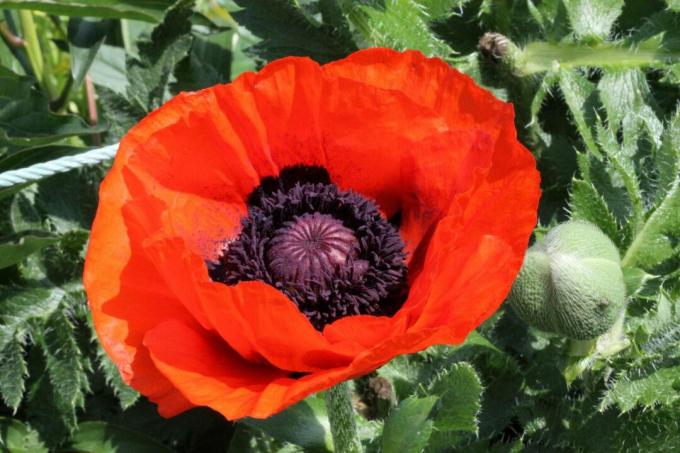
Iceland poppy (Papaver nudicaule)
The Icelandic poppy, also known as the bare-stemmed poppy, is one of the cold-tolerant poppy species that is found in the subarctic regions of America and Asia, but also in Iceland. The Icelandic poppy is perennial but short-lived. Most of the plants are only 2 years old, but seed profusely, so that there is a good stock of poppy plants in the garden. The rather small species reaches a height of 10 to 60 cm and thrives in full sun on well-drained, lean and poor soils. The leaf-free, i.e. "naked" flower stalk is typical of the species and determines the botanical name. In our latitudes, the cup-shaped flowers appear between May and September, they can be colored in red, orange, yellow or white. As with many poppy species and varieties, mixtures that produce different flower colors are usually offered on the market. In the following we present some varieties and mixtures:
- ‘Champagne Bubbles F1 White’: The Icelandic poppy in white with a light yellow center reaches a height of up to 40 cm.
- 'Garden gnome': The dwarf Icelandic poppy 'Gartenzwerg' is probably one of the slowest-growing poppy varieties, because it grows to a maximum height of 10 - 20 cm. Yellow, white and orange shades are included.

- 'pastel blend': This mixture of varieties with a growth height between 30 and 60 cm has petals in different pastel shades. The flowering period is between July and September.
- 'Spring Fever Red': The red-orange petals of this poppy variety are slightly wavy at the edge and have central, light yellow spots. The variety flowers from May to August and reaches a height of about 30 - 50 cm.
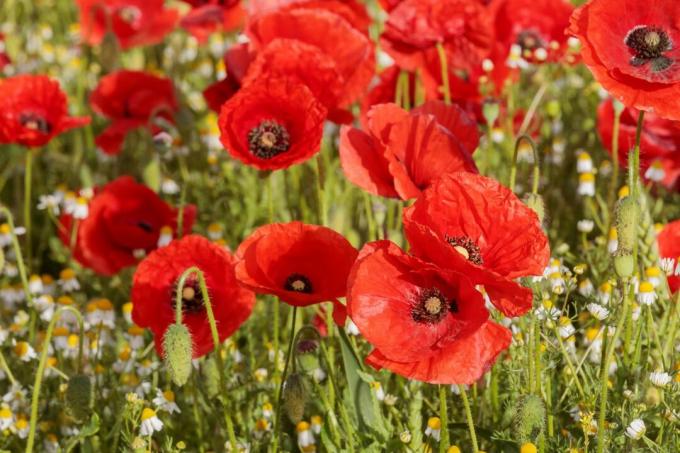
Corn poppy (Papaver rhoeas)
The annual corn poppy is also known as the silk poppy thanks to its papery, thin petals. It is a wild plant native to us in the moderate climate zone, which particularly likes to grow in grain fields together with the cornflower (Centaurea segetum) occurs and conveys a feeling of summer and long, sunny days. The delicate plants have delicate, pinnate leaves and reach a height of 40 to 70 cm. Corn poppies bloom between May and July, the flowers are usually only open for one day and then they shed their petals. After pollination, small, oval-round seed pods appear, each containing thousands of grey-blue seeds. The plants die off as the seeds ripen, scatter their seeds and the following year new poppy plants germinate.
In addition to the red-flowered wild form, there are now many different flower colors to be discovered with the corn poppy - such as pink, pure white or grey-violet as with the 'Amazing Grey' variety. Among the variety of poppy varieties, single and semi-double poppy flowers can be discovered, such as the 'Shirley Double' variety. You can read a large selection of varieties and everything else you need to know about this dainty poppy species in our plant portrait about the poppy.

Tip: In addition to the corn poppy, the pure red flowering sand poppy (Papaver argemone) and the orange seed poppy (Papaver dubium) has been native to Germany for a long time and occurs wild in sunny, well-drained locations.
Ladybird poppy (Papaver commutatum)
The ladybird poppy thrives like the corn poppy and reaches a height of about 10 to 50 cm. Between May and June it produces its flowers on thin, hairy but leafless stems. However, these are deep red in color and have large, black spots at the base of the petal. Hence the German name of Papaver commutatum. The 'Ladybird' variety forms particularly showy flowers and reaches a height of up to 30 cm.
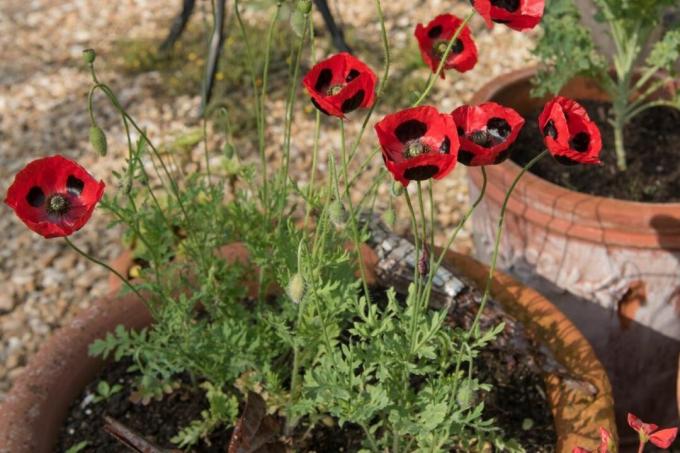
Opium poppy (Papaver somniferum)
The annual opium poppy has an inglorious reputation among the poppies. However, there are numerous varieties that are low in the active alkaloids and are grown as ornamentals or for obtaining poppy seeds for poppy oil and as a baking ingredient. In Austria in particular, the opium poppy is cultivated over large areas, but it also thrives wonderfully in the garden and offers edible poppy seeds and attractive flowers. The flowering period is between May and June. Opium poppy reaches a height of 60 to 150 cm, forms quite large flowers and later bulbous, rather round seed capsules. The most beautiful opium poppy varieties are:
- 'Blue Moon': The poppy variety with huge pink-white flowers with dark spots has large seed heads with deep blue edible seeds. It reaches a growth height of 80 - 120 cm.
- 'Danish Flag': This is a striking poppy variety with fringed petals in bright red and large, white basal spots. It can grow between 60 - 90 cm high.
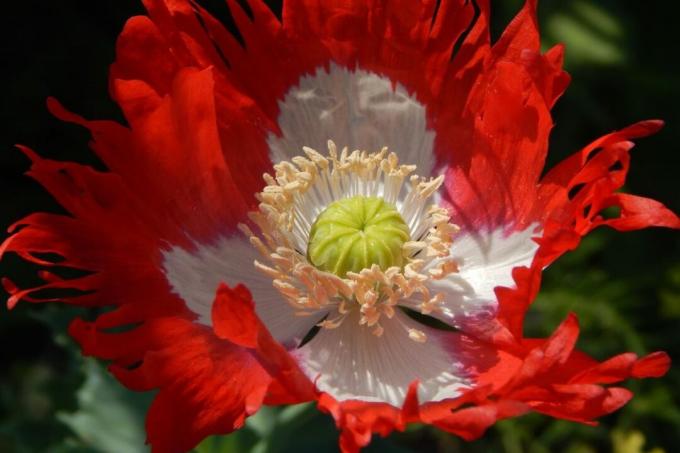
- Flemish Antique: This double poppy variety with multicolored white and pink petals fits well in vintage gardens and grows to around 100 cm in height.
- 'grey poppy': Classic poppy variety from Austria for seed production. It is therefore very stable, high-yield, nutty in taste and forms large seed heads up to 100 cm high. The flowers are white in color with pink spots.
Tip: Also the poppy kind Papaver canescens is referred to as gray poppy, but is not a native variant or one planted in our gardens, but a wild, yellow-flowered poppy from Central Asia and Siberia.
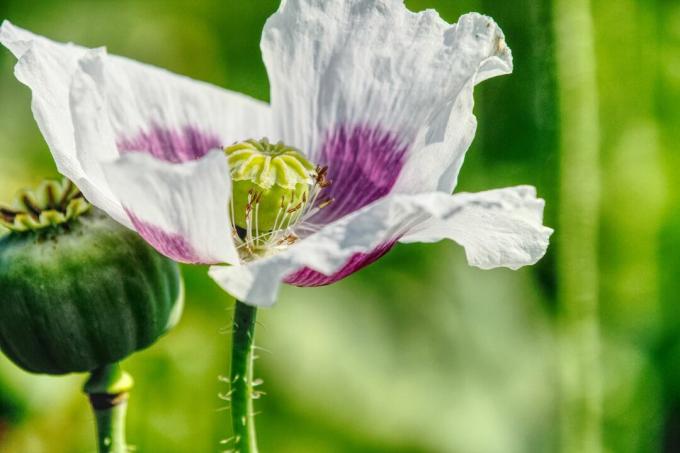
- 'Hen and Chickens': The poppy variety shows the most unusual seed heads, because the bulbous capsule is surrounded by numerous mini capsules, like a hen by her chicks. The flower itself is strawberry red with violet basal spots.
- 'Lauren's Grape': This simple, deep berry colored poppy poses with burgundy basal spots and almost white stamens. This makes it one of the most contrasting newer poppy varieties with edible seeds and a growth height of between 60 and 100 cm.
- 'Black Peony': Also known as 'Schwarzer Paeonienmohn' is the deep wine-red poppy variety with almost completely double flowers peonies (Paeonia) recall. The variant is about 70 - 90 cm high.
- 'white poppy': The extraordinary baking poppy variety with creamy-white seeds is particularly well-known and popular in the Arabian region. The flowers of the up to 150 cm high poppy are white with purple basal spots.
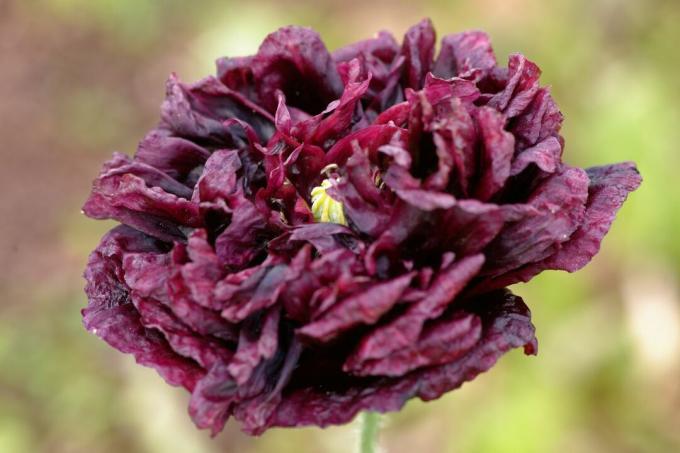
Spanish poppy (Papaver rupifragum)
The Spanish poppy is perennial but short-lived and likes to self-seed in the garden, like so many other poppy species. It forms 30 to 60 cm high plants and flowers between June and September. The Spanish poppy shows bright orange-red flowers and later its typical, elongated capsule fruits, which clearly distinguish it from other species. It prefers to thrive in dry, sunny locations and is hardy to temperatures below -20 °C. The best known variety is the terracotta colored ‘Flore Pleno’.

Turkish poppy (Papaver orientale)
The Oriental or Turkish poppy is a perennial shrub that grows between 70 and 100 cm high. It grows like clumps, disappears completely after flowering and only forms fresh foliage again in autumn. The cup-shaped flowers, up to 18 cm in diameter, appear between May and June. Oriental poppy originally comes from Armenia, the Caucasus region and Iran. It prefers dry to fresh, well-drained, light to heavy soil in full sun.
- 'Beauty of Livermere': The vigorous variety with a height of up to 100 cm convinces with deep red flowers and black basal spots. The Turkish poppy 'Beauty of Livermere' can be propagated true to type via its seeds.
- 'Harvest Moon': The vigorous poppy variety 'Harvest Moon' forms bright orange flowers on plants 70 - 80 cm high. It grows sprawling and can be as wide as it is high.
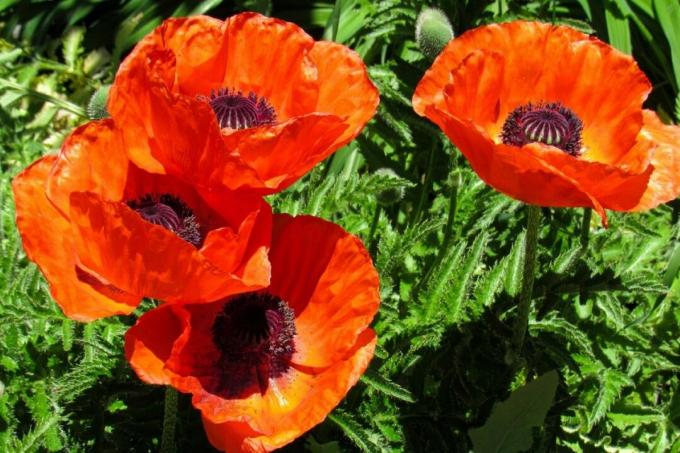
- 'Marlene': The poppy variety 'Marlene' develops rather small, burgundy red flowers and reaches a height of about 70 cm.
- 'Patty's Plum': This variety forms up to 70 cm high plants and showy, violet flowers. The Oriental poppy 'Patty's Plum' originally comes from England and was selected in the 1990s.
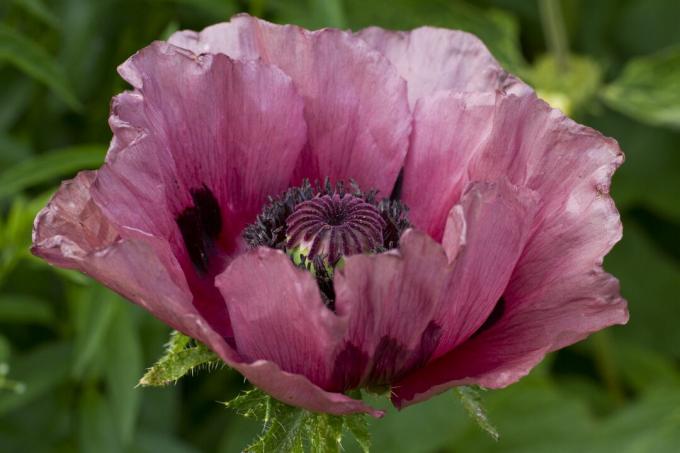
- 'Pink Perfection': The 40 - 80 cm high variety shines with large, pink petals with a wavy edge and black base spots. The poppy variety, which is also suitable for pots, blooms between May and July.
- 'Princess Victoria Louise': The Turkish poppy 'Princess Victoria Louise' produces salmon pink flowers with black spots. The popular variety reaches a height of 50 - 80 cm.
- 'Royal Wedding': The Turkish poppy 'Royal Wedding' brings a pure white flower color to the garden. The flowers can grow up to 20 cm in size and have a violet basal spot at the base.

Dwarf poppy (Papaver miyabeanum)
A cushion-forming, ground-covering poppy is Papaver miyabeanum. On average, it only reaches a height of 10 to 15 cm and a width of about 20 cm. The species is frost hardy and semi-evergreen. Cup-shaped, pale lemon yellow flowers develop between May and June. The optimal location for the dwarf poppy, also known as the Kuril poppy, is sunny on well-drained, fresh to dry soil, for example in steppe or rock garden beds. The most famous variety is 'Pacino'.
Poppies mainly provide pollen and are therefore very popular with many pollinators and especially bumblebees. Further bumblebee friendly plants we present to you in our special article.
...and receive concentrated plant knowledge and inspiration directly in your e-mail inbox every Sunday!
